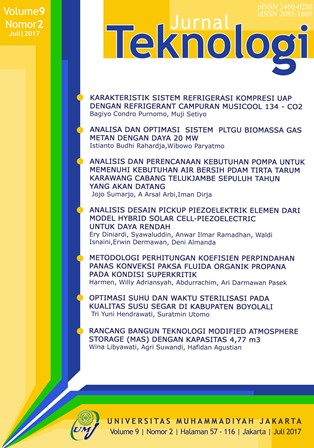KARAKTERISTIK SISTEM REFRIGERASI KOMPRESI UAP DENGAN REFRIGERANT CAMPURAN MUSICOOL 134 - CO2
Main Article Content
Abstract
Downloads
Article Details
COPYRIGHT POLICY
The author(s) of an article published in the Jurnal Teknologi retains ownership of the intellectual property rights in work (s).
PUBLISHING RIGHTS
The author(s) of an article published in the Jurnal Teknologi have unrestricted publication rights. The authors give the Jurnal Teknologi the right to publish the article and designate the Faculty of Engineering Universitas Muhammadiyah Jakarta Publishing as the original publisher of the article.
LICENSING POLICY
Journal of Mechanical Engineering and Sciences is an open-access journal that follows the Creative Commons Non-Commercial 4.0 International License (CC BY-NC 4.0), which states that:

Under this license, the reusers must give appropriate credit, provide a link to the license, and indicate if changes were made. Users may do so in any reasonable manner, but not in any way that suggests the licensor endorses users or their use.
Please take the time to read the whole license agreement (https://creativecommons.org/licenses/by-nc/4.0/). As long as reusers follow the license conditions, the owner cannot withdraw these freedoms. The following components are included under this license:
 Attribution: Users must provide appropriate attribution, including a link to the license, and indicate whether or not they made any modifications. Users are free to do so reasonably, but not in a manner that indicates the licensee approves of their usage.
Attribution: Users must provide appropriate attribution, including a link to the license, and indicate whether or not they made any modifications. Users are free to do so reasonably, but not in a manner that indicates the licensee approves of their usage.
 NonCommercial: Users may not use the material for commercial purposes.
NonCommercial: Users may not use the material for commercial purposes.
References
Agrawal, M. K. and Matani, A. G. (2013) ‘Evaluation of Vapour Compression Refrigeration System Using Different Refrigerants’, International Journal of Engineering and Innovative Technology, 2(9), pp. 86–92.
Alsaad, M. A. and Hammad, M. A. (1998) ‘The application of propane/butane mixture for domestic refrigerators’, Applied Thermal Engineering, 18(9–10), pp. 911–918. doi: 10.1016/S1359-4311(97)00113-0.
Austin, N., Kumar, P. S. and Kanthavelkumaran, N. (2012) ‘Thermodynamic Optimization of Household Refrigerator Using Propane – Butane as Mixed Refrigerant’, International Journal of Engineering Research and Applications, 2(6), pp. 268–271.
Brown, J. S., Yana-motta, S. F. and Domanski, P. a (2002) ‘Comparitive analysis of an automotive air conditioning systems operating with CO 2 and R134a’, International Journal of Refrigeration 25 (2002) 19–32, 25, pp. 19–32. doi: 10.1016/S0140-7007(01)00011-1.
Dai, B., Li, M., Ma, Y., Dang, C., Li, M., Tian, H. and Ma, Y. (2014) ‘Thermodynamic performance assessment of carbon dioxide blends with low-global warming potential (GWP) working fluids for a heat pump water heater’, International Journal of Refrigeration. Elsevier Ltd, 64, pp. 942–952. doi: 10.1016/j.ijrefrig.2014.11.009.
Dalkilic, a. S. and Wongwises, S. (2010) ‘A performance comparison of vapour-compression refrigeration system using various alternative refrigerants’, International Communications in Heat and Mass Transfer. Elsevier B.V., 37(9), pp. 1340–1349. doi: 10.1016/j.icheatmasstransfer.2010.07.006.
Globalindo Niaga Prima (no date) Menggunakan Musicool Refrigerant yang Ramah Linkungan dan Hemat Listrik Pada Mesin AC Sebagai Alternatif Pengganti Freon - Globalindo Niaga Prima. Available at: http://www.globalindoprima.com (Accessed: 10 February 2017).
Han, X. H., Li, P., Xu, Y. J., Zhang, Y. J., Wang, Q. and Chen, G. M. (2013) ‘Cycle performances of the mixture HFC-161 + HFC-134a as the substitution of HFC-134a in automotive air conditioning systems’, International Journal of Refrigeration, 36(3), pp. 913–920. doi: 10.1016/j.ijrefrig.2012.10.027.
Li, G., Eisele, M., Lee, H., Hwang, Y. and Radermacher, R. (2014) ‘Experimental investigation of energy and exergy performance of secondary loop automotive air-conditioning systems using low-GWP (global warming potential) refrigerants’, Energy. Elsevier Ltd, 68, pp. 819–831. doi: 10.1016/j.energy.2014.01.018.
Liao, S. Y., Cheng, Q., Jiang, D. M. and Gao, J. (2005) ‘Experimental study of flammability limits of natural gas-air mixture’, Journal of Hazardous Materials, 119(1–3), pp. 81–84. doi: 10.1016/j.jhazmat.2004.09.031.
Mahajan, R. Y. and Borikar, S. A. (2014) ‘Performance Evaluation of Domestic Refrigerator Using Hc- 12a Refrigerant as an Alternative Refrigerant to R12 And R134a’, The International Journal Of Engineering And Science, 3(10), pp. 26–37.
Nagalakshmi, K. and Yadav, G. M. (2014) ‘The Design and Performance Analysis of Refrigeration System Using R12 & R134a Refrigerants’, Journal of Engineering Research and Applications, 4(2), pp. 638–643.
Pérez-García, V., Belman-Flores, J. M., Navarro-Esbrí, J. and Rubio-Maya, C. (2013) ‘Comparative study of transcritical vapor compression configurations using CO2 as refrigeration mode base on simulation’, Applied Thermal Engineering. Elsevier Ltd, 51(1–2), pp. 1038–1046. doi: 10.1016/j.applthermaleng.2012.10.018.
Sarkar, J. and Bhattacharyya, S. (2009) ‘Assessment of blends of CO2 with butane and isobutane as working fluids for heat pump applications’, International Journal of Thermal Sciences. Elsevier Masson SAS, 48(7), pp. 1460–1465. doi: 10.1016/j.ijthermalsci.2008.12.002.
Setiyo, M., Soeparman, S., Wahyudi, S. and Hamidi, N. (2016) ‘A simulation for predicting potential cooling effect on LPG-fuelled vehicles’, in AIP Conference Proceedings. American Institute of phisics, p. 30002. doi: 10.1063/1.4943426.
United Nations (1998) Kyoto Protocol To the United Nations Framework Convention and Climate Change. doi: 10.1111/1467-9388.00150.
Wang, K., Eisele, M., Hwang, Y. and Radermacher, R. (2010) ‘Review of secondary loop refrigeration systems’, International Journal of Refrigeration. Elsevier Ltd and IIR, 33(2), pp. 212–234. doi: 10.1016/j.ijrefrig.2009.09.018.
Wongwises, S. and Chimres, N. (2005) ‘Experimental study of hydrocarbon mixtures to replace HFC-134a in a domestic refrigerator’, Energy Conversion and Management, 46, pp. 85–100. doi: 10.1016/j.enconman.2004.02.011.
Yadav, P. and Sharma, A. (2015) ‘Exergy Analysis of R134a Based Vapour Compression Refrigeration Tutor’, in National Conference on Advances in Engineering, Technology and Management. Sadopur: Maharishi Markandeshwar University, pp. 73–77.

